Guitars, Amps & Drums
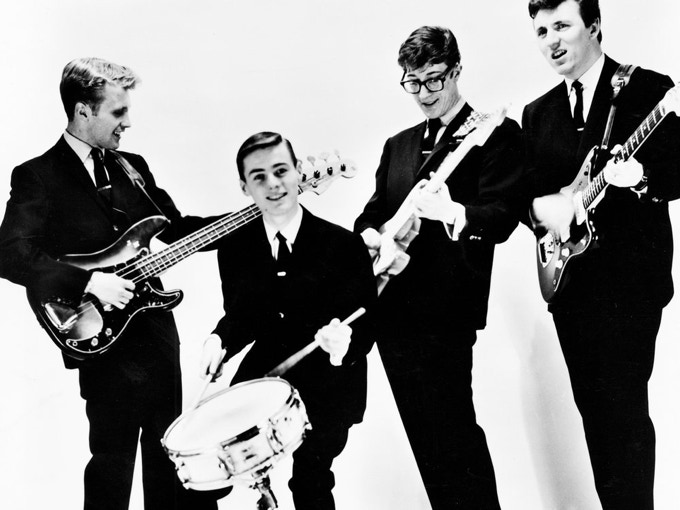
For this chapter, guitar enthusiast Ron (Chris’s husband) takes over with some musing about The Shadows’ gear. This one is for the geeks and it’ll concentrate on the early days and the original four members.
Hank’s iconic red Fender Stratocaster has become synonymous with the man himself: but surely he didn’t always play one? He’s a muso – almost by definition he must have some other guitars! And what about the other guys? What did they play?
Hank
Well, as with so many of us, Hank’s first musical instrument was the piano. He went for lessons when he was eight until eleven. In truth, he wasn’t that interested. He says he’d rather have been out playing football. When he went to grammar school Hank used the “extra homework” excuse to give it up. After a while he got interested in Trad. Jazz and used to go to shows at the Newcastle City Hall. When some of his school friends wanted to start a band, he said he’d like to play clarinet, as that was what his favourite musicians played. He couldn’t afford a clarinet, of course, so it didn’t happen. Hank’s first actual instrument turned out be the banjo, bought from a school French teacher for £2 10s, which he paid off at 2/6d a week!
After he’d learnt a few chords (having left a string off, because he figured it was easier with just 4!) Hank joined a local Jazz band. He clearly had a knack for the instrument and he soon started taking over some of the solos. Skiffle was also very big at that time, and Bruce was nuts about it. Hank started The Crescent City Skiffle Group, while Bruce was in a rival group, The Railroaders.
Then on his sixteenth birthday, Hank’s parents gave him his first guitar, a Höfner Congress. Coincidentally, it cost 16 guineas – a lot of money. In the UK,
the German-made Höfner was the top brand of guitar for most people. Fenders and Gibsons were to all intents and purposes unobtainable because they were from the USA; and in post-war Britain, commercial American musical instrument imports were still prohibited. After a while Hank fitted a pickup to the Congress so that he could be heard playing solos and joined Bruce in The Railroaders.
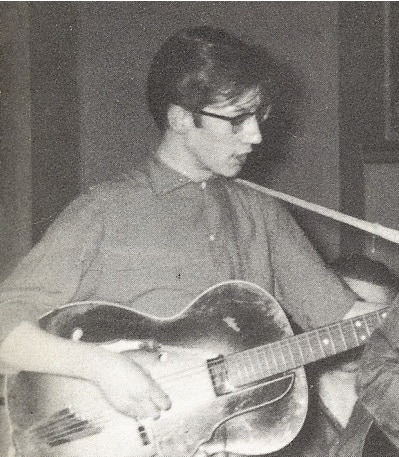
Höfner Congress
While Hank was in the Railroaders, a singer called Eddie Silver joined them. Together with a great voice, he had an American electric guitar, a lovely, but battered, black Vega, which was over 20 years old. Hank later bought that guitar from Eddie and used it right up to the Kalin Twins tour in October 1958. Eventually he sold the guitar to Bruce, who can be seen playing it in Serious Charge and Expresso Bongo.
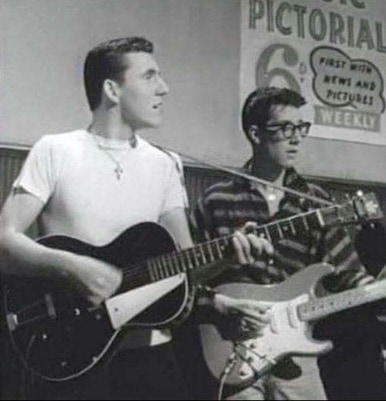
Bruce with the Vega in Expresso Bongo
After the Kalin Twins tour, Hank bought a solid body Antoria LG50 for £35 from a shop in London. It wasn’t very good, but it served him for the Oh Boy! shows, the first two Shadows’ Singles and for recording Cliff’s first album in September 1959.
With Cliff’s increasing success, it was decided in 1959 that Hank should finally have a decent guitar. They were all big fans of Buddy Holly and knew that he played a Fender Stratocaster, and they also particularly liked the sound of Ricky Nelson’s guitarist, James
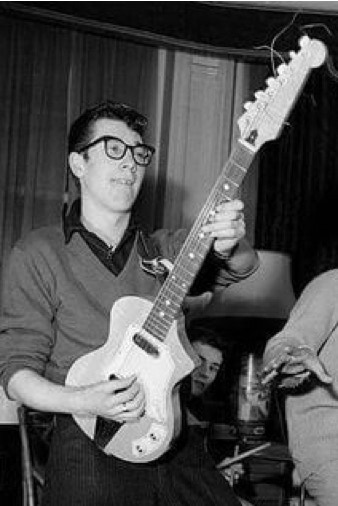
Hank’s Antoria LG50
Burton. Because the Stratocaster was the top of the Fender range of guitars at that time, they assumed that James used a Strat., too. There was still a post-war trade ban on American musical instruments, but they could be imported personally. Cliff was making much more money than The Shadows so he agreed to import one and pay for it.
They wrote off to California for a brochure, which eventually arrived. After much thumbing through and subsequent discussion, they decided on the most expensive guitar in the book: a flamingo-pink, gold-plated, tremolo-equipped Stratocaster with a bird’s-eye maple neck. When it arrived a few weeks later in its red, velvet-lined, tweed case, they gathered round, opened it up and just gaped at it. For a while Hank couldn’t bring himself to actually pick it up! It was in fact the first time he had ever seen a Strat. for real, let alone actually played one.
The first recording featuring the Stratocaster was their third Single, Saturday Dance. Later Hank discovered that the guitar that James Burton actually played, was a Fender Telecaster. For the nerds, the serial number of the Strat. was 34346. The guitar is now in Bruce’s possession.
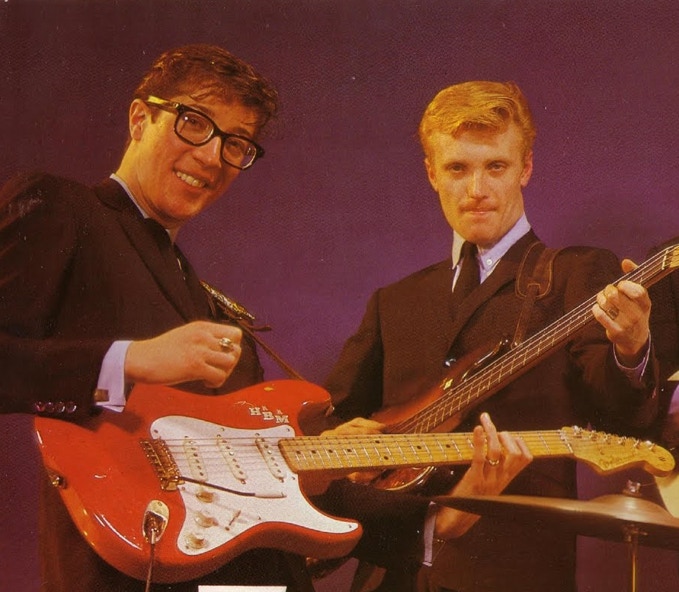
Hank with his Stratocaster
It seems an awful lot of trouble to have gone to; and unbeknown to them, things were just about to change. On June 9th 1959, the import ban on US musical instruments was lifted. It would take the retail trade a while to stock up, but it would soon be possible to buy American guitars in the UK.
By now, Hank was already using his other trademark, the echo box. Joe Brown had got one, decided he didn’t really like it and was looking for someone to take it off his hands. Hank tried it and loved it – it gave him the slap-back echo of American Rock ’n’ Roll records. He never looked back. This original one was an Italian-made Meazzi Echomatic. He subsequently used various other
makes and models from Vox, Binson, Maestro, and others.
All these things worked on the same principle which was based on a tape recorder. A loop of recording tape, or, in some cases, a magnetisable drum, would continuously revolve past a recording head and a series of playback heads. So the guitar signal would be recorded onto
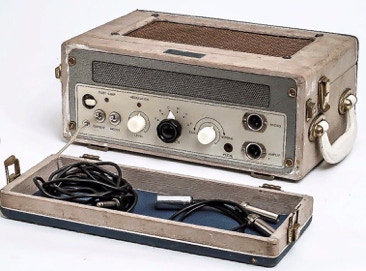
Meazzi Echomatic
the tape and then, after a very short delay, would be played back several times. In this way, a series of echos was produced. Owing to their somewhat Heath Robinson nature, these echo boxes were not very reliable and Hank, who used the effect almost all the time, went through a succession of different units.
One problem with the Fender Stratocaster is what happens when a string breaks. All guitar players break a string from time to time. Usually, it is no problem to carry on until the end of the song with only 5 strings and then change to another guitar. With a tremolo-equipped guitar, however, due to the design, the other strings will immediately go out of tune. During a live performance this is nothing short of a nightmare, so Hank soon took to keeping a spare guitar on stage next to his amplifier.
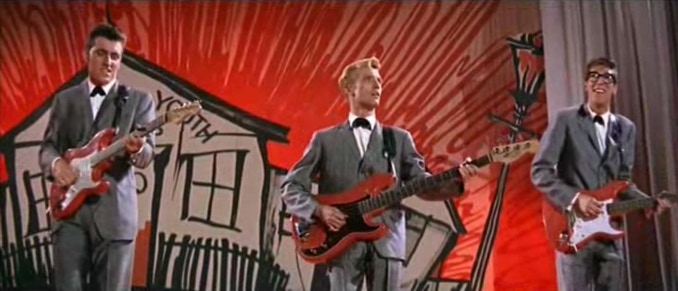
Three matching Fenders
Hank’s second Strat. appears as his main instrument in early 1961. It was still red, but can be distinguished from the first one by having a rosewood neck and chrome hardware. It features in The Young Ones and Summer Holiday. This was then followed by a white Stratocaster in 1963. That sounds like sacrilege! But, actually, I love white Stratocasters - my own is white!
In 1964, Hank, Bruce and John Rostill (bass player at that time) gave up the Fenders and took to playing UK-made Burns guitars, which were branded “Marvin” models. One of them was a 12-string, which Hank still plays to this day. Thankfully, after a while, they reverted to the Fender Strats.
Bruce
Bruce’s first guitar was an acoustic of unknown name, bought for just under £5 when he formed The Railroaders.
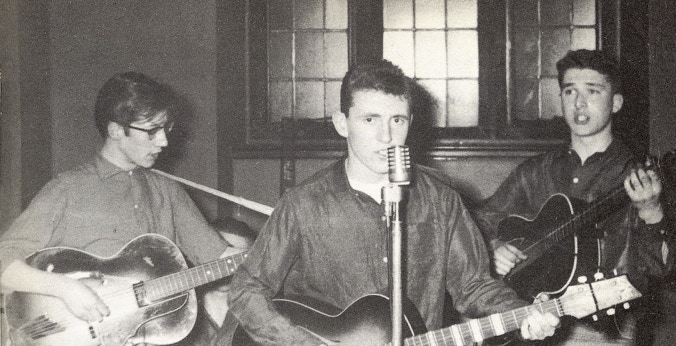
The Railroaders
In London he graduated to a white Grimshaw semi-acoustic electric, which he used at the beginning of The Drifters. This was a double cutaway, deep-bodied, arch-top guitar with two pickups; a sort of budget (if you squint a bit) Gretsch White Falcon!
He also had the acoustic Vega, sold to him by Hank. This has a distinctive white pick-guard and Bruce used it in Cliff’s first two films. There’s a picture of Bruce with the Vega back up the page.
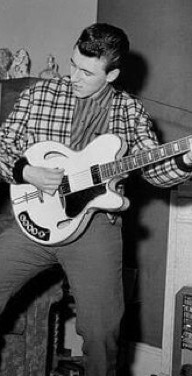
Bruce & Grimshaw
On the Apache recording, Bruce borrowed Cliff’s Gibson J200 acoustic guitar for the first time. They found the tone was so much better that it soon became recognised as Bruce’s trademark jangly rhythm sound. However, it was almost impossible to use an acoustic guitar on stage given the then primitive state of PA systems, so for concerts he would still use his electric.
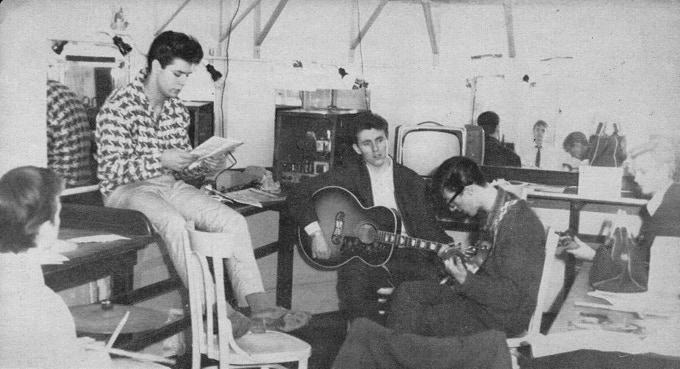
Bruce with Cliff’s Gibson J200
The year after Hank got his Strat., Bruce bought one of the first Jazzmasters, which Fender had just introduced as their top instrument. His was finished in “sunburst”. There’s no written evidence, but the guitar first appears after the 1960 tour of America by Cliff & The Shadows. It’s more than likely that both Bruce and Jet got their first Fenders during that tour.
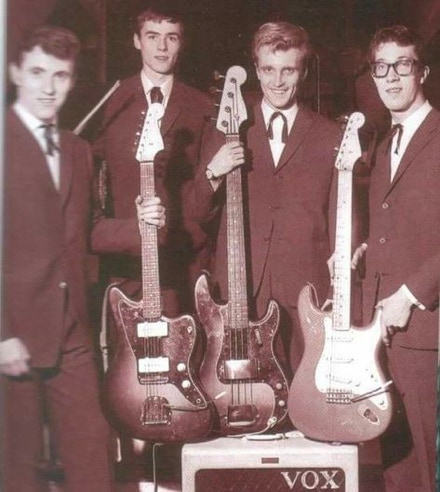
Bruce and Jet with their new Fenders
And now –the infamous White Telecaster! There are many, many photos, all probably from the same photo session, where Bruce is holding a white Fender Telecaster. These photos appear all over the place, including on the
cover of their first LP, THE SHADOWS, and the cover of The Shadows By Themselves paperback by Royston Ellis. However, there’s almost no photographic evidence of this guitar ever being played on stage, apart from film of some TV concerts. So where did it come from? And what happened to it afterwards? These topics are the subject of much internet debate. Bruce even claims in his book that the white Telecaster was borrowed specially for the photo session, and that the price tag is still dangling from it!
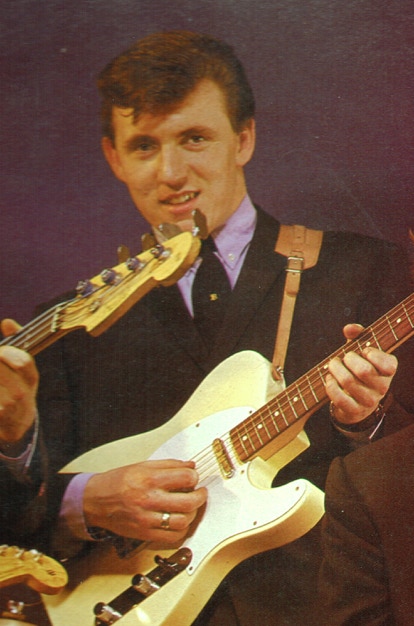
Bruce and the white Telecaster
(Why? Did he forget and leave the Jazzmaster at home?) Despite Bruce’s claim, there are two videos from a TV concert on this site, clearly showing him playing the Telecaster… plus this one from a 1961 ATV Television Cliff! show:
Willie and the Hand Jive
Later in 1961 Bruce was playing a red Stratocaster, matching Hank’s. A Stratocaster was to remain his main stage instrument from then on, apart from the Burns episode mentioned above.
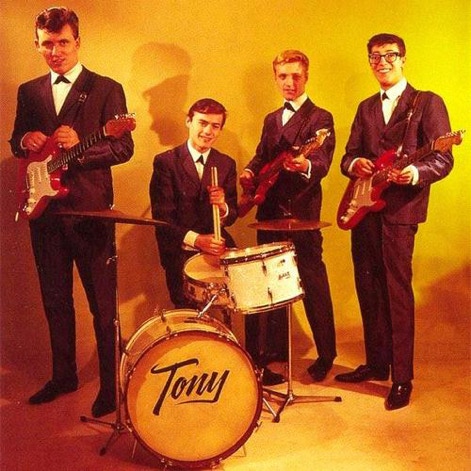
Bruce with red Stratocaster
Jet
Jet started his musical chops with a clarinet. However he soon found that in order to sound anything like reasonable, some serious learning had to be done. So within a year he had swapped the clarinet for an upright double bass. Although the Fender bass guitar was used in the USA, it was almost unknown outside. The upright bass was the standard fare for all Jazz combos in the UK. This stood him in good stead for a couple of years and he ended up being offered a job by an experienced Jazz drummer, Tony Crombie, whose band had been booked to back Wee Willie Harris on tour.
Jet and Tony Crombie got along fine and one day (1958?) Tony suggested
that Jet should take a look at a new contraption in a Charing Cross Road music shop. This was a 4-string Framus electric bass guitar, a German made semi-acoustic bass. Jet took one look and thought, “Yes, I’ll have a bit of that!” He immediately became one of the first electric bass guitar players in the country, if not the first one, and was consequently much in demand.

Jet pleased with his Framus Bass
He used the Framus bass for all the early recordings and tours and the first two of Cliff’s films – right up to the end of 1959, after which he got his first
Fender, a Precision bass finished in “sunburst”. This was the first Fender bass in the country and was probably brought back from the American tour in early 1960. It can be seen in the Apache video.
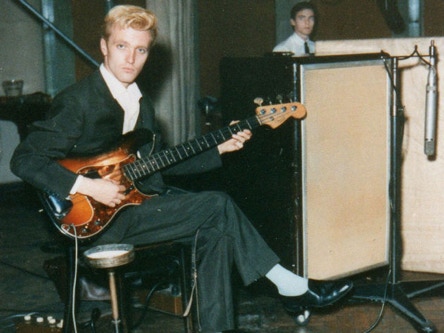
Fender Precision Bass
According to Wikipedia: in 2010 Jet was presented with a special award from Fender for his services to their company in effectively launching their bass guitar in the UK.
The “sunburst” bass guitar was then on everything until 1961 when Jet appeared with a red Fender Precision bass. Both Bruce and Hank had new guitars as well, and it looks as though they wanted to have matching instruments for the forthcoming film The Young Ones; all their guitars were red with rosewood necks. There’s a picture above from the film. Here they are at the Globe Theatre, Stockton-on-Tees, on 7th February 1961.
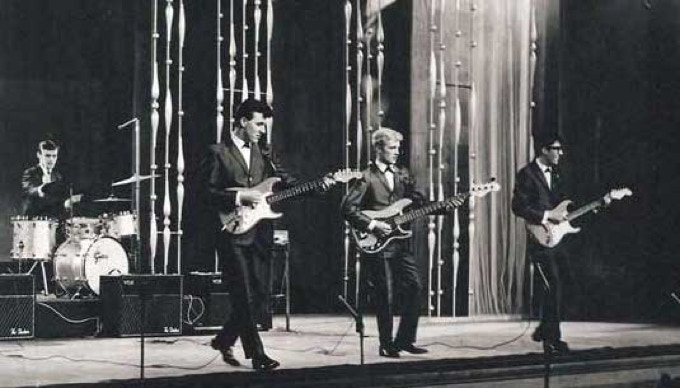
The Globe, Stockton-on-Tees
Incidentally, Jet’s monster hit, Diamonds, with Tony Meehan after they had both left The Shadows, is played on a Gretsch 6-string, semi-acoustic guitar, tuned down one tone to ‘D’. Not a bass guitar at all!
Also there’s a single picture on the internet of Jet with what I eventually found out is a Burns-Weill bass guitar. These were briefly manufactured in 1959 by Jim Burns, who made the guitars, and Henry Weill who supplied the electrics. As there are absolutely no pictures of Jet playing this bass anywhere else, my guess is that he’s trying it out in a shop, or it’s a mate’s guitar.
Interestingly though, 5 years later, Jim Burns supplied all The Shadows with custom white Burns guitars.
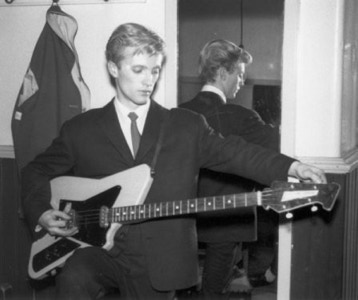
Tony
Having been fascinated by watching drummers on TV, Tony got his first set
of drums for Christmas, aged 10. After a couple of years, he started playing with older friends who had guitars and saxophones. His mother bought him a better kit for £40 when he was 13 or 14 and Tony joined a dance band that played in a club in Paddington. Already he was getting paid 30 bob (£1.50) a night. That kit seemed to last him right up until his 2i’s days.
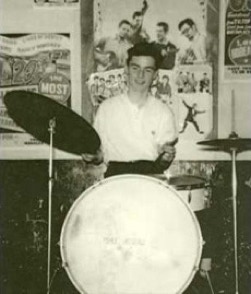
Tony’s first kit after that was the Ajax set in white pearl with Ajax cymbals seen in Expresso Bongo and various early photos. He probably already owned these drums when he joined The Shadows. This was the same kit that later on had the name “Tony” on the front. He still had this drum kit in June 1960 when they recorded Apache: it can be seen in the video.
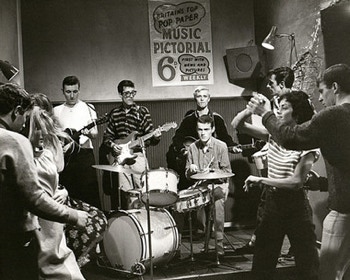
Tony and Ajax kit in Expresso Bongo
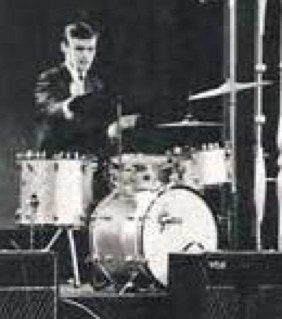
Tony with the Gretsch kit
Then by early 1961 came the American Gretsch Jazz kit finished in “Champagne Sparkle”. This lasted right on through to his later days with Jet Harris. Tony was accomplished on several instruments and, for example, played kettledrums on Kon-Tiki.
Tony describes his kit in The Shadows By Themselves: a 14” x 5½” snare, two 12” x 8” and 14” x 14” tom-toms and a 20” x 14” bass drum. Cymbals were Zildjian: 18” and 20”, and 15” hi-hats. In later life Tony was asked if he still had the “Champagne Sparkle” kit. He said that his boys had split it up between them!
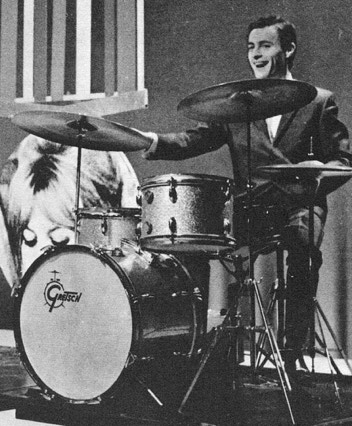
The Gretsch kit later with Jet
Amplifiers
For their first tour with Cliff, Hank & Bruce borrowed their amplifiers, a Selmer 15w and a Vox AC15. After that, they all had their own Vox AC15s, Jet included. Various versions of these amps were used exclusively through the Oh Boy! shows, the recordings and the tours.
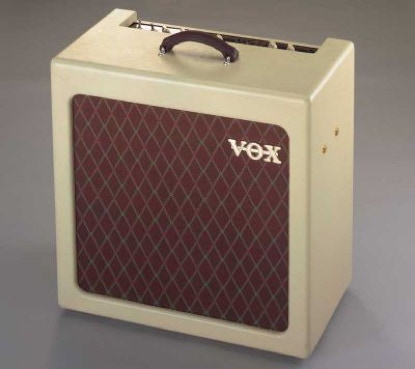
Vox AC15
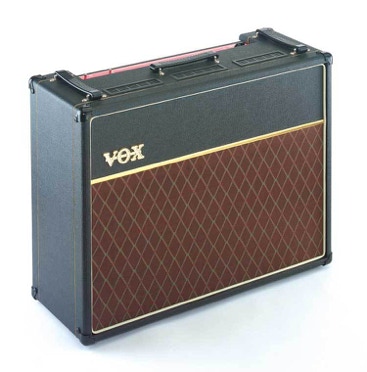
Vox AC30
Although 15 watts was the standard output of guitar amps of the time, The Shadows suffered from the same problem that The Beatles were to experience a few years later: the screaming of the fans during the live shows
drowned out their guitars. To try and overcome this, Hank (Vox say it was Bruce) asked Jennings Musical Industries, who made the amplifiers for Vox, to build him a high-power version with two speakers instead of the single speaker in the AC15. This amp was the AC30.
In late 1960 The Shadows had taken delivery of the new AC30s. The rest is history and legend. The AC30 in its various incarnations went on to become one of the most famous and highly-regarded amplifier designs in the world used by everybody from The Beatles to Brian May.
By Christmas 1960 the AC30s were The Shadows’ standard amps. They used them in their various versions until the break-up in 1968.
So…
Now you know everything you never knew you wanted to know! You’ll be able to identify the instruments in this shot:

Answers:
Grimshaw - Antoria LG50 - Ajax drums - Framus bass
And Finally…
How difficult is it to sound like Hank Marvin? Perhaps not quite as hard as you’d think! Well, you can get pretty close. This bit of kit is so good that, when I first tried it out, my wife rushed into the room under the impression that Hank had dropped round for tea!
Sound like Hank Marvin for under £200
Cookies:
Copyright:
This web site doesn’t save any cookies or any personal data.
Google, however, will track which YouTube videos are played.
If you own the copyright to any content here and wish to receive credit or have it removed, please contact me and I will respond promptly.


